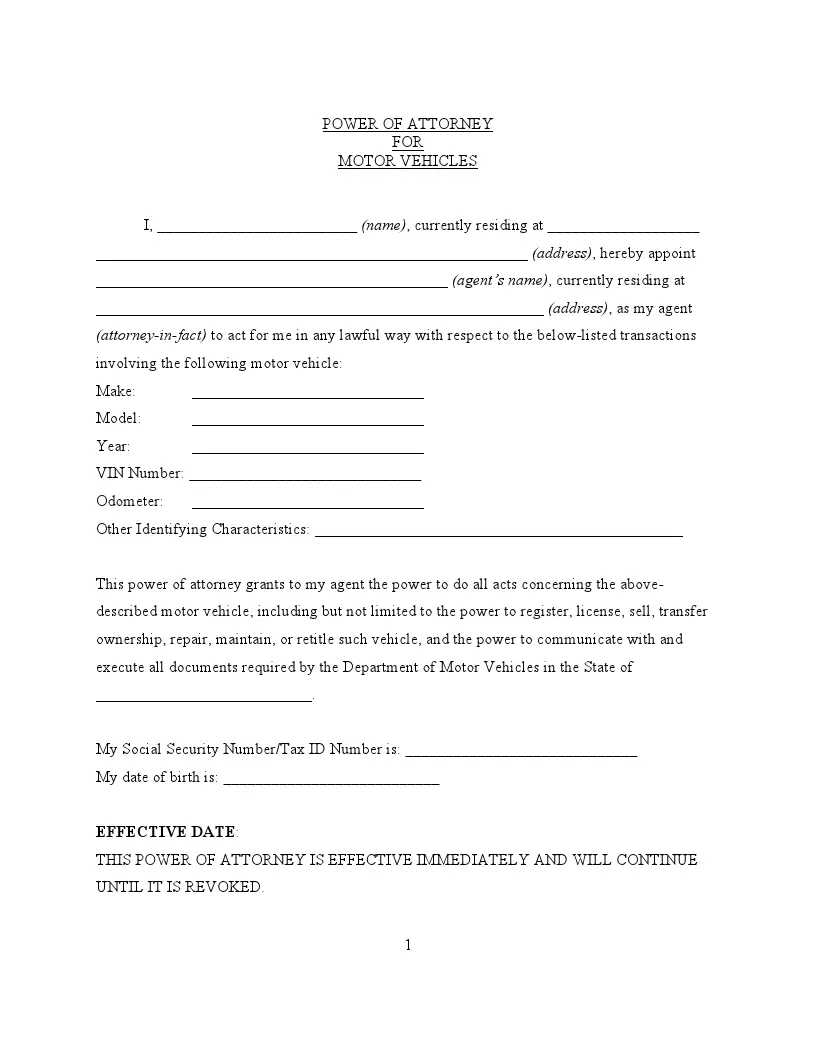Motor Vehicle Power of Attorney Forms
Motor vehicle power of attorney forms can be used to give another person a variety of powers over a vehicle that you (principal) own without transferring ownership of the vehicle to that person. That includes the right to register the vehicle, either in your name or theirs, as well as the right to buy or sell the vehicle on your behalf and sign the relevant paperwork.
You can also ask this person to handle the maintenance of the vehicle, though the specifics are up to you and the individual you designate as your attorney-in-fact (also called representative or agent – as in other power of attorney forms).
The most important thing is that a vehicle power of attorney gives your agent the right to complete DMV interactions for you. You don’t give up your rights over the vehicle when you grant some authority over the vehicle to your agent, but you do share those rights and responsibilities.

Build Your Document
Answer a few simple questions to make your document in minutes
Save and Print
Save progress and finish on any device, download and print anytime
Sign and Use
Your valid, lawyer-approved document is ready
- Alabama
- Alaska
- Arizona
- Arkansas
- California
- Colorado
- Connecticut
- Delaware
- Florida
- Georgia
- Hawaii
- Idaho
- Illinois
- Indiana
- Iowa
- Kansas
- Kentucky
- Louisiana
- Maine
- Maryland
- Massachusetts
- Michigan
- Minnesota
- Mississippi
- Missouri
- Montana
- Nebraska
- Nevada
- New Hampshire
- New Jersey
- New Mexico
- New York
- North Carolina
- North Dakota
- Ohio
- Oklahoma
- Oregon
- Pennsylvania
- South Carolina
- South Dakota
- Tennessee
- Texas
- Utah
- Vermont
- Virginia
- Washington
- West Virginia
- Wisconsin
- Wyoming
When to Use a Vehicle Power of Attorney
One of the most common reasons to use a motor vehicle power of attorney is if the vehicle will need registration when you aren’t able to complete the registration yourself. There are lots of reasons you might not be available, including:
- Traveling when registration is due
- Upcoming medical procedures that prevent you from registering the motor vehicle normally
- Moving to a new location before you can ship the vehicle to your new home
You may also want this type of limited power of attorney if you are relying on someone with more expertise to take care of the vehicle.
It’s also common to use a motor vehicle power of attorney if you want to sell a vehicle but aren’t able to sell it yourself. If you’re moving, for instance, and haven’t sold the vehicle before you move, you might want to designate someone local to sell it for you instead of bringing the vehicle with you to your new location.
These POA also act as DMV power of attorney, so the person you authorize can also handle registration requirements. They will also be able to transfer the title on the vehicle if you are selling it.
Steps to Getting a Vehicle Power of Attorney
There are a lot of ways to get a motor vehicle power of attorney. You can get the form from the DMV, an attorney, or from free forms available online here. Here are the steps to filling out your form and getting everything set up.
Step 1: Get the Form Itself
There are plenty of sources for a motor vehicle power of attorney form. Our free templates are relatively easy to customize for your specific circumstances. You can also hire an attorney to create a custom power of attorney for a car, but that might be quite costly. Lastly, your DMV might be able to provide a local official form for you to fill out; we have listed such forms in the table below.
Step 2: Fill Out the Form
You’ll need to fill out the form including your personal details and the identifying information for your vehicle. Unlike other forms of power of attorney documents, you will need to include your birth date and taxpayer identification number (usually your social security number) on your vehicle power of attorney form.
We’ll go into more detail on this process in the next section.
Step 3: Sign and File Your Power of Attorney
The last step to filling out your car power of attorney forms is to sign and date the form. You may want to see a notary public to get the form notarized, but that isn’t a requirement in all states. You’ll need several copies of the form with a signature: one for yourself, one for your agent or attorney-in-fact (and any successor attorneys), and one copy to file with the DMV.
Signing Requirements by State
| STATE | Signing requirements | State DMV POA Form |
| Alabama | Notary Public | Form MVT 5-13 |
| Alaska | Notary Public | Form 847 |
| Arizona | Notary Public | Form 48-1001 |
| Arkansas | No law | Power of Attorney for Vehicle Transactions |
| California | Owner of Vehicle | Form REG 260 |
| Colorado | Notary Public | Form DR 2175 |
| Connecticut | Two Witnesses and Notary Public | Form A-83 |
| Delaware | Notary Public | Form MV386 |
| Florida | Owner of Vehicle | Form 82053 |
| Georgia | Notary Public | Form T-8 |
| Hawaii | Notary Public | Form DMVL-596 |
| Idaho | Notary Public (if applying for duplicate title) | Form ITD-3368 |
| Illinois | Owner of Vehicle | Form RT-5 |
| Indiana | Notary Public | Form 1940 |
| Iowa | Notary Public | Form 411021 |
| Kansas | Owner of Vehicle | Form TR-41 |
| Kentucky | Notary Public | Form TC 96-336 |
| Louisiana | Notary Public | None |
| Maine | Certified Technician and Notary Public | None |
| Maryland | Owner of Vehicle | Form VR-470 |
| Massachusetts | Certified Technician and Notary Public | None |
| Michigan | Owner of Vehicle | Form TR-128 |
| Minnesota | Certified Technician and Notary Public | None |
| Mississippi | Notary Public | Form 78-003-21-8-1-000 |
| Missouri | Notary Public (not required if signing electronically) | Form 4054 |
| Montana | Notary Public | Form MV65 |
| Nebraska | Notary Public | DMV Power of Attorney |
| Nevada | Notary Public | Form VP136 |
| New Hampshire | Notary Public | None |
| New Jersey | Certified Technician and Notary Public | MSC POA&DAA |
| New Mexico | Notary Public | Form MVD-11020 |
| New York | Notary Public | None |
| North Carolina | Notary Public | Form MVR-63 |
| North Dakota | Certified Technician and Notary Public | None |
| Ohio | Notary Public | Form BMV 3771 |
| Oklahoma | Certified Technician and Notary Public | None |
| Oregon | Owner of Vehicle | Form 735-500 |
| Pennsylvania | Notary Public | None |
| Rhode Island | Certified Technician and Notary Public | None |
| South Carolina | Notary Public | Form MC-25 |
| South Dakota | Notary Public | Form MV-008 |
| Tennessee | Notary Public | Form RV-F1311401 |
| Texas | Owner of Vehicle | Form VTR-271 |
| Utah | Certified Technician and Notary Public | None |
| Vermont | Certified Technician and Notary Public | None |
| Virginia | Owner of Vehicle | Form VSA-70 |
| Washington | Notary Public | Form TD-420-050 |
| Washington D.C. | Owner of Vehicle and Agent | Form DMV-VSPA-01 |
| West Virginia | Owner of Vehicle | Form DMV-9-TR |
| Wisconsin | Certified Technician and Notary Public | None |
| Wyoming | Notary Public | WYDOT Limited Power of Attorney |
How to Fill Out a Vehicle Power of Attorney
Step 1: Fill Out Personal Information for Yourself and Your Agent
This guide is based on a template (PDF) we prepared with the help of a professional attorney. The first step on any vehicle power of attorney form is to fill out the personal identifying information for yourself and your agent. That includes your name and current address and the same details for your attorney-in-fact. You can also include contact information, but your phone number and other possible contact information are completely optional.
If you have a separate mailing address, you should be sure to include that in addition to your living address so that you can receive your updates in a timely manner.

Step 2: Fill Out the Identifying Information for the Vehicle in Question
You’ll need to fill in your vehicle information for each vehicle you want to be covered by the POA. That includes:
- VIN (vehicle identification number)
- Make
- Model
- Year
- Current Odometer reading
You’ll also be asked to include other identifying information for your vehicle. At a minimum, you should include the color of your vehicle and it’s license plates number. If you have stickers or other details added to your car, you may want to list those as well. Even dents and scratches can be considered vehicle information to help distinguish your car from others of the same make and model.

Step 3: Fill Out Birthday and Tax Identification Number
Unlike other kinds of power of attorney documents, your vehicle power of attorney form will typically also require your birthday and tax identification number. That’s partially to help identify the owner and to distinguish you from others who might share your name inside the state.
Your tax identification number is usually your social security number, though you may have a different tax identification number in some circumstances.

Step 4: Determine Successor Attorney-in-fact
You can also choose to add other people to your POA as successor attorneys in fact. these people are authorized as your agent only if your primary agent is unavailable, if you revoke their responsibility, or if they choose not to act.
Having a successor attorney-in-fact can help make your POA more effective, but it isn’t a requirement. You can leave this section blank if you don’t want to designate an individual here.

Step 5: Sign and Date
The last step is to sign and date the POA once all of the motor vehicle information has been filled out. You can sign this form on your own, but it may be considered more legally valid if you go to a notary public and have the form witnessed and notarized in their presence as you put your signature in place.
You’ll need at least three copies of the POA: one copy for yourself, one for your agent (and any successors), and one for the local DMV.

Create a Free Power of Attorney for a Car

